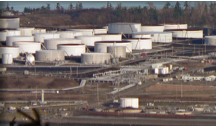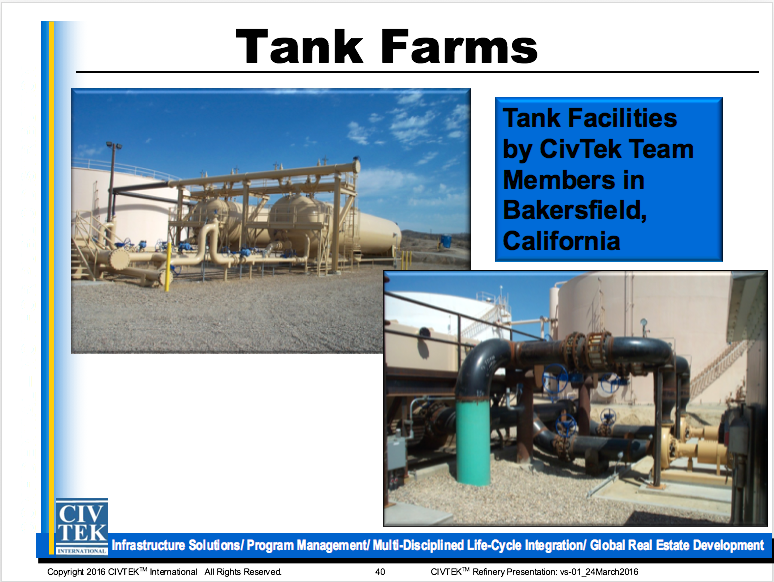Tank Farms
 Tankage must contain sufficient storage for safe plant shutdowns and startups. Shut downs occur with routine maintenance. For scheduled maintenance on individual systems, not all of the refinery requires shut down at once. Redundancy enables system "1A" to be shut down while system "1B" is used in system "1A's" place, thus maintaining operations.
Tankage must contain sufficient storage for safe plant shutdowns and startups. Shut downs occur with routine maintenance. For scheduled maintenance on individual systems, not all of the refinery requires shut down at once. Redundancy enables system "1A" to be shut down while system "1B" is used in system "1A's" place, thus maintaining operations.
If, for any reason, the production should drop or shutdown completely (such as pipeline system failure) there should be enough tankage to keep the refinery running. SAFE and proper shutdown might take 2 to 3 days with a startup taking 3 to 5 days depending on how many systems there are in the plant. There is no instant turn-on switch for a refinery. Each system must be properly started on recycle until there is proper pressure and temperature to operate is achieved.
Temperatures can be controlled at the tanks by utilizing thermo coils or steam coils to heat the product to the proper operating temperature for the plant. In Bakersfield, California refinery operators do this often due to the low gravity (high viscosity) oil to get it to the proper consistency to ship.
An additional refinery operating requirement for tankage, is to maintain constant pressure and temperature for equipment charge pumps. Even with pumps, the refinery needs to properly startup with a recycle to get the right suction and discharge that tanks provide.
In crude oil processing, the storage of raw and finished products is an important factor for smooth, continuous production. Crude oil is delivered via pipeline and stored in large tanks for later processing. The products of distillation are stored and held ready for shipment in tanks of varying sizes.
Feedstock tanks are ALWAYS REQUIRED. Pipeline feedstock flow rate varies. Refineries require controlled feed rates. This is achieved by pumping from tanks. Second, there may be temporary pipeline shutdowns in the feedstock. The refinery may require several days supply on-hand to keep operating through such feedstock pipeline shutdowns. A long enough shutdown in the feedstock will require the plant to be shut down as well. In that case, the plant should be shut down when the feedstock storage is reaching the minimum volume to allow for a safe shut down sequence.


